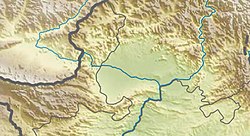
Ashoka, popularly known as Ashoka the Great, was the third Mauryan Emperor of Magadha in the Indian subcontinent during c. 268 to 232 BCE. His empire covered a large part of the Indian subcontinent, stretching from present-day Afghanistan in the west to present-day Bangladesh in the east, with its capital at Pataliputra. A patron of Buddhism, he is credited with playing an important role in the spread of Buddhism across ancient Asia.

Nalanda was a renowned mahavihara in ancient Magadha, eastern India. Considered by historians to be the world's first residential university and among the greatest centers of learning in the ancient world, it was located near the city of Rajagriha and about 90 kilometres (56 mi) southeast of Pataliputra. Operating from 427 until 1197 CE, Nalanda played a vital role in promoting the patronage of arts and academics during the 5th and 6th century CE, a period that has since been described as the "Golden Age of India" by scholars.

Xuanzang, born Chen Hui / Chen Yi, also known by his Sanskrit Dharma name Mokṣadeva, was a 7th-century Chinese Buddhist monk, scholar, traveler, and translator. He is known for the epoch-making contributions to Chinese Buddhism, the travelogue of his journey to India in 629–645 CE, his efforts to bring over 657 Indian texts to China, and his translations of some of these texts. He was only able to translate 75 distinct sections of a total of 1335 chapters, but his translations included some of the most important Mahayana scriptures.
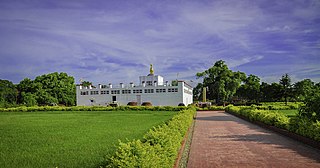
Lumbinī is a Buddhist pilgrimage site in the Rupandehi District of Lumbini Province in Nepal. It is the place where, according to Buddhist tradition, queen Maya gave birth to Siddhartha Gautama at around 566 BCE. Gautama, who, according to Buddhist tradition, achieved Enlightenment some time around 528 BCE, became Shakyamuni Buddha and founded Buddhism. Lumbini is one of many magnets for pilgrimage that sprang up in places pivotal to the life of the Buddha.
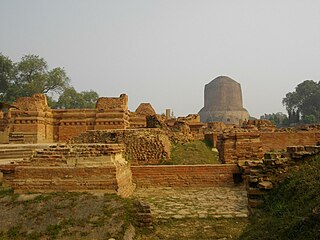
Sarnath is a place located 10 kilometres northeast of Varanasi, near the confluence of the Ganges and the Varuna rivers in Uttar Pradesh, India.

Taxila, also known historically as Takshashila, is a city in the Pothohar region of Punjab, Pakistan. Located in the Taxila Tehsil of Rawalpindi District, it lies approximately 25 kilometres (16 mi) northwest of the Islamabad–Rawalpindi metropolitan area and is just south of the Haripur District of Khyber Pakhtunkhwa. Founded in the 7th century BCE, the city was conquered by Alexander the Great in 326 BCE without a battle because Taxila had a very weak army hence it was immediately surrendered to the Greek Macedons by the locals.

Sirkap is the name of an archaeological site on the bank opposite to the city of Taxila, Punjab, Pakistan.

Major General Sir Alexander Cunningham was a British Army engineer with the Bengal Engineer Group who later took an interest in the history and archaeology of India. In 1861, he was appointed to the newly created position of archaeological surveyor to the government of India; and he founded and organised what later became the Archaeological Survey of India.
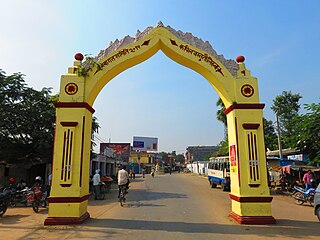
Kapilvastu is a municipality and administrative center of Kapilvastu District in Lumbini Province of southern Nepal. The municipality is located roughly 25 kilometres (16 mi) to the south-west of Lumbini, a UNESCO World Heritage Site and the birthplace of Gautama Buddha.

Shravasti is a town in Shravasti district in Indian State of Uttar Pradesh. It was the capital of the ancient Indian kingdom of Kosala and the place where the Buddha lived most after his enlightenment. It is near the Rapti river in the northeastern part of Uttar Pradesh India, close to the Nepalese border.
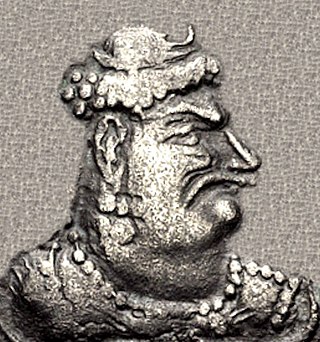
Mihirakula, sometimes referred to as Mihiragula or Mahiragula, was the second and last Alchon Hun king of northwestern region of the Indian subcontinent between 502 and 530 CE. He was a son of and successor to Toramana of Huna heritage. His father ruled the Indian part of the Hephthalite Empire. Mihirakula ruled from his capital of Sagala.

The Dharmarajika Stupa, also referred to as the Great Stupa of Taxila, is a Buddhist stupa near Taxila, Pakistan. It was built over the relics of the Buddha by Ashoka in the 3rd century BCE. The stupa, along with the large monastic complex that later developed around it, forms part of the Ruins of Taxila - which were inscribed as a UNESCO World Heritage Site in 1980.

Buddhism in Pakistan took root in the third century BCE under the Mauryan king Ashoka. The Major Rock Edicts of Ashoka inscribed on rock boulders in Mansehra and Shahbaz Garhi written in the Kharosthi script recording aspects of the emperor's dharma or righteous law represent some of the earliest evidence of deciphered writing in South Asia, dating to middle of the third century BCE. The Indo-Greek king Menander embraced Buddhism as attested in the Milinda Panha, which dates from sometime between 100 BC and 200 AD, following a dialogue with the monk Nāgasena in Sagala, present-day Sialkot.

Vaishali, Vesali or Vaiśālī was a city in present-day Bihar, India, and is now an archaeological site. It is a part of the Tirhut Division.

In religion and spirituality, a pilgrimage is a long journey or search of great moral significance. Sometimes, it is a journey to a sacred place or to a shrine of importance to a person's beliefs and faith. Members of every major religion participate in pilgrimages. A person who makes such a journey is called a pilgrim.

Pushpagiri was an ancient Indian mahavihara or monastic complex located atop Langudi Hill in Jajpur district of Odisha, India. Pushpagiri was mentioned in the writings of the Chinese traveller Xuanzang and some other ancient sources. Until the 1990s, it was hypothesised to be one or all of the Lalitgiri-Ratnagiri-Udayagiri group of monastic sites, also located in Jajpur district. These sites contain ruins of many buildings, stupas of various sizes, sculptures, and other artifacts.

Mohra Muradu is the place of an ancient Buddhist stupa and monastery near the ruins of Taxila, in the Punjab province of Pakistan. The ancient monastery is located in a valley and has views of the surrounding mountains. The monks could meditate in all stillness at this place but were near enough to the city of Sirsukh to go for begging as it is only around 1.5 km away. The city is said to have been built the 2nd century CE and renovated in the 5th century.

Jaulian is a ruined Buddhist monastery dating from the 2nd century CE, located in Taxila, in Pakistan.

According to the Mahāparinibbāṇa Sutta, after attaining parinirvana, the body of Buddha was cremated and the ashes divided among his lay followers.

Gandhāran Buddhism refers to the Buddhist culture of ancient Gandhāra which was a major center of Buddhism in northwestern Pakistan from the 3rd century BCE to approximately 1200 CE. Ancient Gandhāra corresponds to modern day north Pakistan, mainly the Peshawar valley and Potohar plateau as well as Afghanistan's Jalalabad. The region has yielded the Gandhāran Buddhist texts written in Gāndhārī Prakrit the oldest Buddhist manuscripts yet discovered. Gandhāra was also home to a unique Buddhist artistic and architectural culture which blended elements from Indian, Hellenistic, Roman and Parthian art. Buddhist Gandhāra was also influential as the gateway through which Buddhism spread to Central Asia and China.


